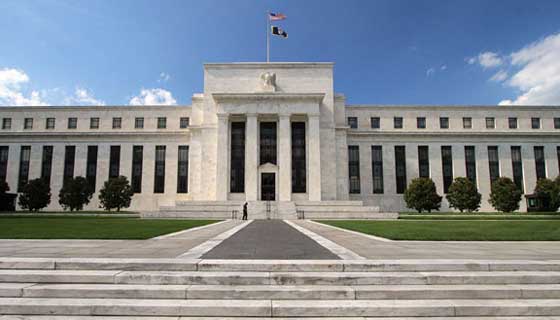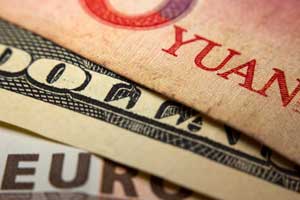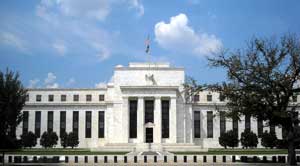
In my post “Usury Comes to America,” I told the story of how the concept of a debt-based banking system became entrenched in western society with the establishment of the Bank of England in 1694. More importantly, this movement has gained momentum thanks to the supporting influence of the Rothschild family; it has shaped our deteriorating financial situation worldwide ever since.
Here is a compressed history of how the Federal Reserve came about.
 After 1863, the American financial system was built on fiat currency. The cornerstone of the banking system was debt—expanding the monetary base required banks to issue loans (debt), supported by an inadequate fractional reserve system. In 1874, legislation was passed that allowed banks to no longer require any reserves of gold or silver when creating new bank notes.
After 1863, the American financial system was built on fiat currency. The cornerstone of the banking system was debt—expanding the monetary base required banks to issue loans (debt), supported by an inadequate fractional reserve system. In 1874, legislation was passed that allowed banks to no longer require any reserves of gold or silver when creating new bank notes.
In other words, they were able to print dollar bills at will, out of thin air, backed by absolutely nothing (See “How Money is Created Out of Nothing!“). This debt-based system was responsible for regular cycles of boom and bust, a series of depressions and recessions in 1873, 1884, 1893, and 1907, culminating in The Great Depression (brought on by the crash of 1929). Each of these major downturns were characterized by deflation and bank runs (in which citizens lost everything).
There was one American organization that, throughout all the ups and downs of booms and busts in the 1800s, reigned supreme, and that was J.P. Morgan. That’s because, during the Panic of 1857, they were quite unexpectedly bailed out by the Bank of England. Over the years, they developed closer and closer ties to the Bank of England and through it, to the House of Rothschild.
“Morgan’s activities in 1895-1896, installing US gold bonds in Europe were based on his alliance with the House of Rothschild.”—Triumph, Gabriel Kolko, Canadian historian
The Panic of 1907
The Panic of 1907 was a major turning point in swaying the public over to a need for a U.S. central banking system.
“Robert Owen, a co-author of the Federal Reserve act, later testified before Congress that the banking industry had conspired to create such financial panics in order to rouse the people to demand “reforms” that served the interests of the financiers.”—Ellen Hodgson Brown, Web of Debt
This particular panic began with the failure of the Knickerbocker Trust Company and the Trust Company of America. It was a story of big money, cartels, and copper, which had become a hot commodity, due to the discovery of electricity. The early 1900s saw the rise of monopolies—under the ownership of what many referred to as “The Robber Barons.”
The major players were J.P. Morgan (dominated finance), Andrew Carnegie (U.S. Steel), and J.D. Rockefeller (monopolized oil). These monopolies were eventually broken up by anti-trust legislation.
“Carnegie built his business himself, and he loved competition; but Morgan was a different type of capitalist. He didn’t build, he bought. He took over other people’s businesses, and he hated competition. In 1901, Morgan formed the first billion dollar corporation, U.S. steel, out of mills he purchased from Carnegie. Early in the 20th Century, Morgan controlled the Wall Street syndicate that financial writer John Moody called ‘the greatest financial power in the history of the world.'”
The Robber Barons were pulling money out of “an empty hat.” Their privately-owned banks held the ultimate credit card, a bottomless source of accounting-entry money that could be ‘lent” to their affiliated corporate mistresses. The funds could then be used to buy out competitors, corner markets in scarce raw materials, make political donations, lobby Congress, and control public opinion.”—Ellen Hodgson Brown, Web of Debt
To make a long story short, in 1907, JP Morgan began circulating rumours that its competitor, Knickerbocker Bank and Trust Co, was insolvent. The next morning, their shares dropped 50% in the stock market. This helped trigger an 11% drop in production, a 26% rise in imports, and an increase in unemployment from 3-8%. But the beginning of the end were the bank runs on the Knickerbocker bank. Lines of depositors formed outside other New York banks and an outright panic ensued.
People slept overnight in these lines, trying to get their money out of the banks as soon as they opened. Credit froze to a point that there was fear that the stock market itself would collapse.
Suddenly, JP Morgan stemmed the flow of money by extending liquidity (for a fee) to the banks that had sustained the biggest runs. They also released optimistic reports to the press, and got religious leaders to mount upbeat sermons.
In other words, JP Morgan (and their backers) completely controlled the financial situation, ruining many businesses and lives, while making money at the same time.
The 1907 Panic highlighted the weaknesses of the national banking system and indirectly led to acceptance amongst the public of a need for a central banking system.
Creation of The Federal Reserve
 The creation of the Federal Reserve is well-documented in “The Creature from Jekyll Island,” by G. Edward Griffin. I highly recommend it. You can find a link on my Recommended Books page.
The creation of the Federal Reserve is well-documented in “The Creature from Jekyll Island,” by G. Edward Griffin. I highly recommend it. You can find a link on my Recommended Books page.
The Jekyll Island Hunt Club was a property off the coast of Georgia, owned by J.P.Morgan. In the fall of 1910, six men boarded a rail car on their way to a duck hunting holiday. It was an 800 mile journey through Atlanta, Georgia, then Savannah, to the small town of Brunswick. The shades on the rail car were pulled shut all the way and the participants were on a first-name-only basis, so that attending servants would not know who they were.
For nine days, this small group met in secret to plan out the creation of a central banking “cartel” for the United States that is still in existence today, of course. This was the beginning of the Federal Reserve System, which allegedly has connections to the Rothschild family through its members. Although Senator Aldrich hosted the meeting, the credit for putting it all together has been attributed to Paul Warberg, who was a partner in Kuhn, Loeb & Co., the Rothschild’s main American banking operation after the civil war.
The meeting at the luxurious Jekyll Island Hunt Club retreat in November 1910, was attended by six men:
- Benjamin Strong, head of J.P. Morgan’s Banker’s Trust;
- Nelson W. Aldrich, chair of the National Monetary Commission;
- A. Piatt Andrew, Assistant Secretary of the Treasury and Special Assistant to the National Monetary Commission (the only other commission member besides Aldrich);
- Paul Warburg, a recent immigrant from a prominent German banking family who was a partner in the New York banking house of Kuhn, Loeb & Co.;
- Frank A. Vanderlip, president of the National City Bank of New York;
- Henry P. Davison, senior partner of J.P. Morgan & Co.;
In order to get the bill passed, the group needed a president who would sign it, so they orchestrated the founding of a new party, the Bull Moose Party, and brought a previous President, Teddy Roosevelt out of retirement to help to syphon votes so that the odds were in favour of getting Woodrow Wilson elected. Wilson knew very little about finance but was under the influence of “Colonel” Edward Mandell House, who lived in the White House and had strong connections to Morgan and the Rothschilds.
They changed the name of the bill from the “Aldrich Bill” to the “Federal Reserve Act “and brought it to the floor of Congress for a vote three days before the Christmas break, on December 22, 1913, when everyone was distracted. President Wilson signed it into law the next day. He’s reported to have regretted what he had done after the fact, saying before he died, “I have unwittingly ruined my country.”
“In plain English, the Federal Reserve Act authorized a private central bank to create money out of nothing, lend it to the government at interest, and control the national money supply, expanding or contracting at will.”—Ellen Hodgson Brown, Web of Debt
Opposition was extremely vocal upon learning how Congress had been duped, with Charles Lindberg calling the Act “the worst legislative crime of the ages”:
“This is the strangest, most dangerous advantage ever replaced in the hands of a special privilege class by any government that ever existed… the financial system has been turned over to… a purely profiteering group. The system is private, conducted for the sole purpose of obtaining the greatest possible profits from the use of other people’s money.”—Representative Charles August Lindberg, 1913
England on the Skids
 After WWI, England was close to broke. She had abandoned the gold standard early in the war so that she could print as much fiat currency as necessary to pay for the war. Introducing that much currency into the marketplace caused inflation to soar. The affect on the pound is that the value dropped substantially.
After WWI, England was close to broke. She had abandoned the gold standard early in the war so that she could print as much fiat currency as necessary to pay for the war. Introducing that much currency into the marketplace caused inflation to soar. The affect on the pound is that the value dropped substantially.
Before the war, Britain has been the major power in the world. After the war, it was only natural that she wanted to regain that status. To do that required going back on the gold standard at the same level she was at previously. However, setting a price for an ounce of gold arbitrarily (without considering the value the market gives your currency) isn’t realistic. If you try to value your money above its actual worth, it causes deflation, which leads to depression.
Before the war, an ounce of gold was priced at $4.86 US. The government decided to peg gold at that same price after the war. Getting back to a stable currency based on gold was deemed important, as it allowed countries to trade and exchange money between themselves at a level that was fair to all.
But when England pegged the pound that high, nobody believed it was worth it. As a result, trade took a nosedive. No country is going to buy your products if they’re over-priced and they can get them from another country for half the price.
Rather than experiencing the inflation of wartime, England began to experience deflation, and a depression followed. Products created in Britain were too highly priced; businesses couldn’t sell them abroad. So England was forced to let the dollar float; it ended up losing a third of its value.
Meanwhile, the United States was doing well. America had also inflated during WWI, but not anywhere near the amount England had. The strategy is common and has been used over and over again over by one government or another the past few hundred years:
“… to have one nation deliberately inflate its currency at a rate greater than the other nation so that real purchasing power, in terms of international trade, moves from the more inflating to the less inflating nation. This is a method truly worthy of the monetary scientists. It is so subtle and so sophisticated that not one in one thousand would even think of it, much less object to it. It was, therefore, the ideal method chosen in 1925 to benefit England at the expense of America.”—G. Edward Griffin, The Creature from Jekyll Island
The Secret Meeting of 1927
 Montagu Norman became Governor of the Bank of England in 1920. Benjamin Strong had become the first Governor of the Federal Reserve Bank of New York in 1914, just after its formation. Mr. Strong had been one of the original six in the rail car at Jekyll Island.
Montagu Norman became Governor of the Bank of England in 1920. Benjamin Strong had become the first Governor of the Federal Reserve Bank of New York in 1914, just after its formation. Mr. Strong had been one of the original six in the rail car at Jekyll Island.
Norman was considered by many to be eccentric, if not mentally unbalanced. Nonetheless (or perhaps, because of it), the two of them became close, spending many holidays together, and otherwise communicating weekly by cable in almost total secrecy. They were determined to use their financial power to force all major countries of the world to go on the gold standard and to use central banks to control the world economy, without interference from governments.
Norman spent a good deal of his time on steamships travelling the world, keeping in touch with central bankers in various countries. On July 1, 1927, he arrived in New York Harbor (under another name) on the Mauritania and went into conference with Benjamin Strong. They agreed, with Andrew Mellon, the US Secretary of the Treasury, to inflate the US monetary system.
This resulted in an increase in US bank reserves of $445 million and lowered the rediscount rate to member banks from 4 to 3.5 percent, allowing the banks to borrow more reserves, which in turn allowed them to increase loans to business and the public, thereby inflating the currency. It flooded the market with over $10 billion in under six years (based on a fractional reserve multiple).
Real estate and the stock market were the beneficiaries. Inflation in the US also caused prices of goods and services to rise, making them uncompetitive on the international market. It did just the opposite to British products, which greatly increased Britain’s overall income from trade.
It created massive bubbles in both real estate and the stock market in the US, while gold flowed from the US to Britain, thereby shoring up Britain’s economy, lifting her out of depression.
It also eventually led to the 1929 stock market crash, because when money is “cheap,” people borrow it to speculate, similar to what’s going on in our economy today.
Throughout history, whenever governments inflate to a high degree (or a lower degree over a longer period of time), it leads to inflation. Lower interest rates allow investors to borrow more money and speculate in the stock market. In actual fact, when governments inflate, they’re lowering the value of our money. In 2017, we have a dollar that’s worth 4% of its original value (at the time the Federal Reserve was formed). A four cent dollar makes it extremely difficult to stay afloat as a family. Standards of living suffer and, in an attempt to keep up those standards, families go further and further into debt. Eventually, there’s no way out.
This same formula was at work all through the 1800s, causing booms and busts each time. You can recognize today’s housing bubbles in Canada and Australia (the US housing bubble has burst once already due to subprime mortgages in 2007, but has crept up close to its previous highs and is about to crash again). Stock markets all over the world are on the verge of topping out, and crashing. Expect an international market crash in early 2018.
____________________
I’m fascinated by the march of cycles throughout history. It’s uncanny how the traits at 172 and 516 year cycle tops stamp themselves on the characters who seek the highest office. Society also takes on the subtle imprints of an era long past. If you’re sensitive to the work of Dr. Raymond Wheeler, for example, Alexander Chizhevski, Nicolai Kondratiev, or Edward Dewey, it becomes obvious how the past comes full circle. Past cycles predict the future. You can get a good sense of how to navigate the upcoming social and political changes by simply studying the past.




Bitcoin—-people forget that every market top in history has been led by the NEWEST high technology.
http://www.telegraph.co.uk/business/2017/12/30/plunge-volatility-index-stokes-fears-crash/
This is why President Trump wants to turn control of our monetary system and the economy back to the political branches, as the constitution requires
Really interesting post!